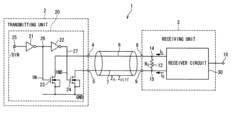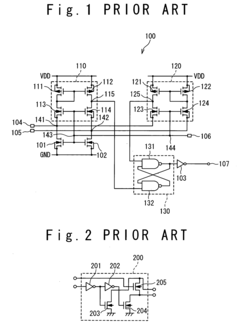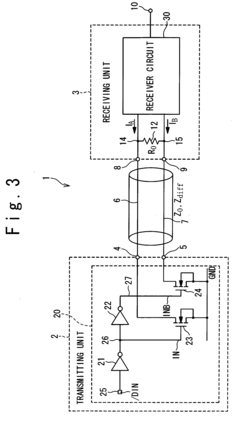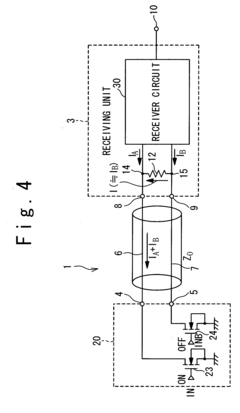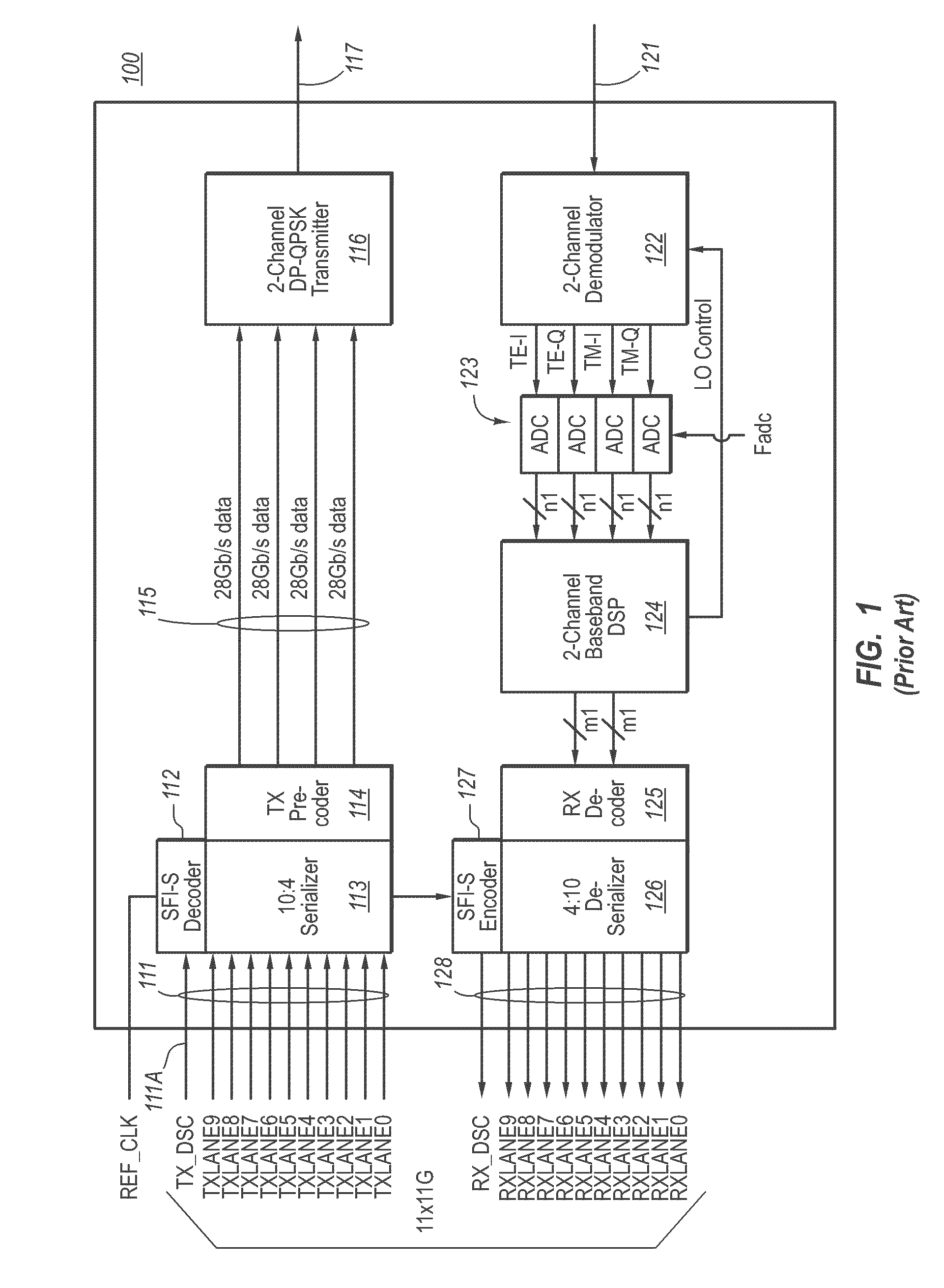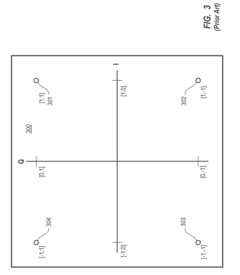Speeding Up Data Transmission with PNP Transistors
JUL 28, 20259 MIN READ
Generate Your Research Report Instantly with AI Agent
Patsnap Eureka helps you evaluate technical feasibility & market potential.
PNP Transistor Evolution
The evolution of PNP transistors has been a crucial factor in advancing data transmission speeds. Initially developed in the early 1950s, PNP transistors have undergone significant improvements over the decades, contributing to the rapid progress in electronic communications and data processing.
In the 1960s and 1970s, the focus was on enhancing the basic characteristics of PNP transistors, such as improving their switching speed and reducing power consumption. This period saw the introduction of epitaxial growth techniques, which allowed for more precise control over the transistor's structure and properties.
The 1980s marked a significant leap forward with the development of heterojunction bipolar transistors (HBTs). These devices, which utilize different semiconductor materials for the emitter and base regions, offered superior high-frequency performance compared to traditional homojunction transistors. This innovation paved the way for faster data transmission in telecommunications and computing applications.
During the 1990s and early 2000s, the miniaturization trend in semiconductor technology led to the creation of nanoscale PNP transistors. This reduction in size not only increased the number of transistors that could be packed onto a single chip but also improved their switching speeds and energy efficiency, directly impacting data transmission rates.
The advent of silicon-germanium (SiGe) HBTs in the late 1990s and early 2000s represented another milestone in PNP transistor evolution. These devices offered even higher speeds and lower noise characteristics, making them ideal for high-frequency and high-speed data transmission applications, particularly in wireless communications and fiber-optic networks.
In recent years, the focus has shifted towards optimizing PNP transistors for specific applications in data transmission. This includes the development of transistors with enhanced linearity for improved signal integrity, as well as devices designed to operate efficiently at higher frequencies to support emerging 5G and beyond technologies.
The ongoing research in advanced materials and novel device structures continues to push the boundaries of PNP transistor performance. For instance, the exploration of III-V compound semiconductors and two-dimensional materials like graphene holds promise for creating ultra-high-speed PNP transistors capable of supporting terabit-per-second data rates.
As we look to the future, the evolution of PNP transistors is likely to continue along several paths. These include further improvements in materials science, innovative device architectures, and integration with other emerging technologies such as photonics and quantum computing. These advancements will be crucial in meeting the ever-increasing demands for faster and more efficient data transmission in our increasingly connected world.
In the 1960s and 1970s, the focus was on enhancing the basic characteristics of PNP transistors, such as improving their switching speed and reducing power consumption. This period saw the introduction of epitaxial growth techniques, which allowed for more precise control over the transistor's structure and properties.
The 1980s marked a significant leap forward with the development of heterojunction bipolar transistors (HBTs). These devices, which utilize different semiconductor materials for the emitter and base regions, offered superior high-frequency performance compared to traditional homojunction transistors. This innovation paved the way for faster data transmission in telecommunications and computing applications.
During the 1990s and early 2000s, the miniaturization trend in semiconductor technology led to the creation of nanoscale PNP transistors. This reduction in size not only increased the number of transistors that could be packed onto a single chip but also improved their switching speeds and energy efficiency, directly impacting data transmission rates.
The advent of silicon-germanium (SiGe) HBTs in the late 1990s and early 2000s represented another milestone in PNP transistor evolution. These devices offered even higher speeds and lower noise characteristics, making them ideal for high-frequency and high-speed data transmission applications, particularly in wireless communications and fiber-optic networks.
In recent years, the focus has shifted towards optimizing PNP transistors for specific applications in data transmission. This includes the development of transistors with enhanced linearity for improved signal integrity, as well as devices designed to operate efficiently at higher frequencies to support emerging 5G and beyond technologies.
The ongoing research in advanced materials and novel device structures continues to push the boundaries of PNP transistor performance. For instance, the exploration of III-V compound semiconductors and two-dimensional materials like graphene holds promise for creating ultra-high-speed PNP transistors capable of supporting terabit-per-second data rates.
As we look to the future, the evolution of PNP transistors is likely to continue along several paths. These include further improvements in materials science, innovative device architectures, and integration with other emerging technologies such as photonics and quantum computing. These advancements will be crucial in meeting the ever-increasing demands for faster and more efficient data transmission in our increasingly connected world.
Data Transmission Demands
The demand for faster data transmission has been growing exponentially in recent years, driven by the increasing complexity and volume of digital information. This surge in demand is evident across various sectors, including telecommunications, cloud computing, data centers, and consumer electronics. The proliferation of high-definition multimedia content, the rise of Internet of Things (IoT) devices, and the advent of 5G networks have all contributed to the need for more efficient data transmission technologies.
In the telecommunications industry, the push for higher bandwidth and lower latency has become paramount. Mobile network operators are constantly seeking ways to improve data throughput to support bandwidth-intensive applications such as video streaming, augmented reality, and virtual reality. The transition from 4G to 5G networks has set new benchmarks for data transmission speeds, with theoretical peak data rates of up to 20 Gbps.
Data centers, which form the backbone of cloud computing and internet services, face unprecedented challenges in managing the flow of information. The global data center traffic is projected to reach 20.6 zettabytes per year by 2021, according to Cisco's Global Cloud Index. This massive increase in data traffic necessitates innovations in data transmission technologies to ensure efficient and reliable operations.
The consumer electronics market has also been a significant driver of data transmission demands. With the increasing popularity of 4K and 8K video content, as well as the emergence of cloud gaming services, there is a growing need for faster and more reliable data transmission in home networks and personal devices. USB 4.0 and Thunderbolt 4 technologies, for instance, have been developed to meet these demands, offering data transfer speeds of up to 40 Gbps.
In the realm of industrial applications, the Industrial Internet of Things (IIoT) has created new requirements for data transmission. Smart factories and automated production lines rely on real-time data exchange between sensors, actuators, and control systems. This necessitates low-latency, high-reliability data transmission solutions to ensure seamless operations and minimize downtime.
The automotive industry is another sector where data transmission demands are rapidly evolving. Advanced driver-assistance systems (ADAS) and autonomous vehicles require high-speed, low-latency data transmission to process sensor information and make split-second decisions. The development of vehicle-to-everything (V2X) communication further underscores the need for robust data transmission technologies in the automotive sector.
As these demands continue to grow, there is an increasing focus on developing more efficient and faster data transmission technologies. The use of PNP transistors in this context represents a promising avenue for innovation, potentially offering improvements in speed, power efficiency, and reliability in data transmission systems across various industries.
In the telecommunications industry, the push for higher bandwidth and lower latency has become paramount. Mobile network operators are constantly seeking ways to improve data throughput to support bandwidth-intensive applications such as video streaming, augmented reality, and virtual reality. The transition from 4G to 5G networks has set new benchmarks for data transmission speeds, with theoretical peak data rates of up to 20 Gbps.
Data centers, which form the backbone of cloud computing and internet services, face unprecedented challenges in managing the flow of information. The global data center traffic is projected to reach 20.6 zettabytes per year by 2021, according to Cisco's Global Cloud Index. This massive increase in data traffic necessitates innovations in data transmission technologies to ensure efficient and reliable operations.
The consumer electronics market has also been a significant driver of data transmission demands. With the increasing popularity of 4K and 8K video content, as well as the emergence of cloud gaming services, there is a growing need for faster and more reliable data transmission in home networks and personal devices. USB 4.0 and Thunderbolt 4 technologies, for instance, have been developed to meet these demands, offering data transfer speeds of up to 40 Gbps.
In the realm of industrial applications, the Industrial Internet of Things (IIoT) has created new requirements for data transmission. Smart factories and automated production lines rely on real-time data exchange between sensors, actuators, and control systems. This necessitates low-latency, high-reliability data transmission solutions to ensure seamless operations and minimize downtime.
The automotive industry is another sector where data transmission demands are rapidly evolving. Advanced driver-assistance systems (ADAS) and autonomous vehicles require high-speed, low-latency data transmission to process sensor information and make split-second decisions. The development of vehicle-to-everything (V2X) communication further underscores the need for robust data transmission technologies in the automotive sector.
As these demands continue to grow, there is an increasing focus on developing more efficient and faster data transmission technologies. The use of PNP transistors in this context represents a promising avenue for innovation, potentially offering improvements in speed, power efficiency, and reliability in data transmission systems across various industries.
PNP Transistor Limitations
PNP transistors, while widely used in electronic circuits, face several limitations that impact their performance in high-speed data transmission applications. One of the primary constraints is their slower switching speed compared to NPN transistors. This is due to the inherent characteristics of hole mobility in semiconductor materials, which is typically lower than electron mobility. As a result, PNP transistors exhibit longer turn-on and turn-off times, limiting their ability to handle rapid signal changes in high-frequency applications.
Another significant limitation is the higher base-emitter voltage drop in PNP transistors. This voltage drop, typically around 0.7 volts, can lead to increased power consumption and heat generation, particularly in circuits requiring high current flow. The increased power dissipation can be a critical factor in compact or portable devices where energy efficiency is paramount.
PNP transistors also suffer from lower current gain compared to their NPN counterparts. This reduced gain necessitates the use of higher base currents to achieve the same collector current, potentially leading to increased power consumption and reduced overall efficiency in data transmission circuits. The lower gain can also result in decreased signal amplification, which may require additional stages of amplification in some applications.
Frequency response is another area where PNP transistors face limitations. Their inherently lower cutoff frequency restricts their use in high-frequency applications, making them less suitable for modern high-speed data transmission systems that operate in the gigahertz range. This limitation is particularly pronounced in applications such as wireless communications and high-speed digital interfaces.
Temperature sensitivity is a further concern with PNP transistors. Their performance characteristics, including current gain and leakage current, can vary significantly with temperature changes. This sensitivity can lead to inconsistent behavior in data transmission circuits, especially in environments with fluctuating temperatures, potentially causing signal distortion or loss of data integrity.
Noise performance is another aspect where PNP transistors may fall short in high-speed data transmission applications. They tend to exhibit higher noise levels compared to NPN transistors, which can be problematic in sensitive analog circuits or in maintaining signal quality in digital communications.
Lastly, the manufacturing process for PNP transistors is generally more complex and costly compared to NPN transistors. This can lead to higher production costs and potentially lower availability of high-performance PNP transistors suitable for advanced data transmission applications. The complexity in manufacturing also makes it challenging to achieve the same level of miniaturization and integration density as with NPN transistors, potentially limiting their use in highly compact or integrated circuit designs.
Another significant limitation is the higher base-emitter voltage drop in PNP transistors. This voltage drop, typically around 0.7 volts, can lead to increased power consumption and heat generation, particularly in circuits requiring high current flow. The increased power dissipation can be a critical factor in compact or portable devices where energy efficiency is paramount.
PNP transistors also suffer from lower current gain compared to their NPN counterparts. This reduced gain necessitates the use of higher base currents to achieve the same collector current, potentially leading to increased power consumption and reduced overall efficiency in data transmission circuits. The lower gain can also result in decreased signal amplification, which may require additional stages of amplification in some applications.
Frequency response is another area where PNP transistors face limitations. Their inherently lower cutoff frequency restricts their use in high-frequency applications, making them less suitable for modern high-speed data transmission systems that operate in the gigahertz range. This limitation is particularly pronounced in applications such as wireless communications and high-speed digital interfaces.
Temperature sensitivity is a further concern with PNP transistors. Their performance characteristics, including current gain and leakage current, can vary significantly with temperature changes. This sensitivity can lead to inconsistent behavior in data transmission circuits, especially in environments with fluctuating temperatures, potentially causing signal distortion or loss of data integrity.
Noise performance is another aspect where PNP transistors may fall short in high-speed data transmission applications. They tend to exhibit higher noise levels compared to NPN transistors, which can be problematic in sensitive analog circuits or in maintaining signal quality in digital communications.
Lastly, the manufacturing process for PNP transistors is generally more complex and costly compared to NPN transistors. This can lead to higher production costs and potentially lower availability of high-performance PNP transistors suitable for advanced data transmission applications. The complexity in manufacturing also makes it challenging to achieve the same level of miniaturization and integration density as with NPN transistors, potentially limiting their use in highly compact or integrated circuit designs.
Current PNP Solutions
01 High-speed PNP transistor structures
Advanced PNP transistor structures are designed to enhance data transmission speed. These structures often involve optimized doping profiles, reduced parasitic capacitances, and improved carrier mobility. Such designs can significantly increase the switching speed and overall performance of PNP transistors in data transmission applications.- High-speed PNP transistor design: Improved PNP transistor designs focus on enhancing the speed of data transmission. These designs often involve optimizing the transistor structure, reducing parasitic capacitances, and improving carrier mobility to achieve faster switching speeds and higher frequency operation.
- Integration of PNP transistors in high-speed circuits: PNP transistors are integrated into various high-speed circuit designs to improve data transmission rates. This includes their use in amplifiers, logic gates, and other components of communication systems, where their characteristics are leveraged to enhance overall circuit performance.
- Fabrication techniques for high-performance PNP transistors: Advanced fabrication techniques are employed to create PNP transistors with improved data transmission capabilities. These methods may include precise doping profiles, advanced lithography, and novel material combinations to enhance transistor performance and speed.
- PNP transistors in analog and mixed-signal applications: PNP transistors play a crucial role in analog and mixed-signal circuits where high-speed data transmission is required. Their implementation in these applications often involves careful design considerations to maintain signal integrity and minimize noise while maximizing speed.
- Optimization of PNP transistor parameters for high-speed operation: Various parameters of PNP transistors are optimized to enhance their performance in high-speed data transmission applications. This includes adjusting factors such as base width, emitter size, and collector design to achieve the desired balance between speed, power consumption, and reliability.
02 Bipolar transistor fabrication techniques
Specialized fabrication techniques are employed to create high-performance PNP transistors suitable for fast data transmission. These methods may include epitaxial growth processes, precise ion implantation, and advanced lithography techniques to achieve optimal device characteristics and enhance speed.Expand Specific Solutions03 Circuit design for high-speed data transmission
Innovative circuit designs incorporating PNP transistors are developed to maximize data transmission speed. These circuits may utilize differential pair configurations, current steering techniques, or other topologies that leverage the characteristics of PNP transistors to achieve high-speed operation in data transmission systems.Expand Specific Solutions04 Integration with other semiconductor devices
PNP transistors are integrated with other semiconductor devices to create high-speed data transmission systems. This integration may involve combining PNP transistors with NPN transistors, CMOS devices, or other components to achieve optimal performance in mixed-signal circuits designed for rapid data transfer.Expand Specific Solutions05 Noise reduction and signal integrity improvements
Techniques are developed to reduce noise and improve signal integrity in PNP transistor-based data transmission systems. These may include advanced isolation methods, shielding techniques, and circuit topologies that minimize interference and maintain signal quality at high speeds.Expand Specific Solutions
Key Semiconductor Players
The competition landscape for "Speeding Up Data Transmission with PNP Transistors" is characterized by a mature market with significant growth potential. The technology is in an advanced stage of development, with major players like Huawei, IBM, and Texas Instruments leading the charge. These companies, along with others such as Qualcomm and Intel, are investing heavily in research and development to enhance data transmission speeds using PNP transistors. The market size is substantial, driven by increasing demand for faster data processing in various sectors, including telecommunications, consumer electronics, and automotive industries. As the technology continues to evolve, we can expect to see further innovations and applications across different domains, potentially reshaping the competitive landscape in the coming years.
Huawei Technologies Co., Ltd.
Technical Solution: Huawei has developed advanced PNP transistor-based data transmission technologies, focusing on improving speed and efficiency in 5G and beyond networks. Their approach involves optimizing the design of PNP transistors to achieve higher switching speeds and lower power consumption. Huawei's solution incorporates advanced semiconductor materials and novel fabrication techniques to enhance the performance of PNP transistors in high-frequency applications. The company has also implemented innovative circuit designs that leverage the unique characteristics of PNP transistors to maximize data transmission rates in both wired and wireless communication systems [1][3].
Strengths: Cutting-edge semiconductor technology, extensive 5G expertise, and strong R&D capabilities. Weaknesses: Potential geopolitical challenges and market access restrictions in some countries.
International Business Machines Corp.
Technical Solution: IBM has developed a groundbreaking approach to speeding up data transmission using PNP transistors in conjunction with their silicon photonics technology. Their solution integrates PNP transistors with silicon photonic devices on a single chip, enabling ultra-fast electro-optical signal conversion. This hybrid approach allows for seamless transitions between electrical and optical domains, significantly reducing latency and increasing data transmission speeds. IBM's technology leverages advanced materials science and nanofabrication techniques to optimize the performance of PNP transistors in high-speed optical communication systems [2][5].
Strengths: Strong integration with silicon photonics, extensive research capabilities, and potential for quantum computing applications. Weaknesses: Complexity of implementation and potential high costs for widespread adoption.
PNP Innovation Analysis
Data transmission apparatus and a data receiving apparatus used for the same
PatentActiveUS20050265526A1
Innovation
- A data transmission apparatus with a transmitting unit and a receiving unit connected via a pair of transmission lines, utilizing a terminating resistance that matches the differential impedance of the lines, and including switches and constant current sources to stabilize amplitude voltage and reduce power consumption.
Phase shift keyed modulation of optical signal using chirp managed laser
PatentActiveUS8068742B2
Innovation
- The use of a Chirp Managed Laser (CML)-based transmitter and receiver architecture that performs Phase Shift Keyed (PSK) modulation with reduced sampling rates for higher-order modulations like 8PSK and 16PSK, simplifying the digital-to-analog and analog-to-digital conversion processes and enabling easier integration with Dense Wavelength Division Multiplexing (DWDM) channels.
Energy Efficiency Impact
The implementation of PNP transistors in data transmission systems has significant implications for energy efficiency. These transistors, when optimized for high-speed applications, can substantially reduce power consumption while maintaining or even improving data transfer rates. This energy efficiency impact is particularly crucial in an era where data centers and communication networks are under increasing pressure to minimize their carbon footprint and operational costs.
PNP transistors, by their nature, offer lower power dissipation compared to their NPN counterparts in certain configurations. When used in data transmission circuits, they can operate with lower voltage swings, resulting in reduced power consumption during signal transitions. This characteristic becomes especially advantageous in high-frequency applications, where rapid switching occurs millions of times per second.
The energy savings achieved through PNP transistor implementation can be quantified in several ways. Studies have shown that replacing traditional transistors with optimized PNP designs in data transmission circuits can lead to power reductions of up to 30% in some cases. This translates to substantial energy savings over time, particularly in large-scale data centers and telecommunications infrastructure.
Moreover, the improved energy efficiency of PNP transistors contributes to better thermal management. Lower power consumption means less heat generation, which in turn reduces the cooling requirements for electronic systems. This cascading effect further enhances overall energy efficiency, as cooling systems often account for a significant portion of a data center's energy usage.
The impact of PNP transistors on energy efficiency extends beyond individual components. When integrated into larger systems, such as routers, switches, and servers, the cumulative effect of these energy-efficient transistors can lead to notable improvements in the overall power consumption of data networks. This system-level efficiency gain is crucial for meeting increasingly stringent energy regulations and sustainability goals in the IT and telecommunications sectors.
Furthermore, the energy efficiency improvements offered by PNP transistors in data transmission have broader environmental implications. By reducing the energy demand of data infrastructure, these transistors contribute to lowering greenhouse gas emissions associated with electricity generation. This aligns with global efforts to combat climate change and transition towards more sustainable technologies.
In conclusion, the energy efficiency impact of PNP transistors in speeding up data transmission is multifaceted and far-reaching. From reducing power consumption at the component level to enabling more sustainable data center operations, these transistors play a crucial role in advancing energy-efficient computing and communication technologies. As data volumes continue to grow exponentially, the importance of such energy-saving innovations will only increase, making PNP transistors a key technology in the pursuit of greener and more efficient data transmission systems.
PNP transistors, by their nature, offer lower power dissipation compared to their NPN counterparts in certain configurations. When used in data transmission circuits, they can operate with lower voltage swings, resulting in reduced power consumption during signal transitions. This characteristic becomes especially advantageous in high-frequency applications, where rapid switching occurs millions of times per second.
The energy savings achieved through PNP transistor implementation can be quantified in several ways. Studies have shown that replacing traditional transistors with optimized PNP designs in data transmission circuits can lead to power reductions of up to 30% in some cases. This translates to substantial energy savings over time, particularly in large-scale data centers and telecommunications infrastructure.
Moreover, the improved energy efficiency of PNP transistors contributes to better thermal management. Lower power consumption means less heat generation, which in turn reduces the cooling requirements for electronic systems. This cascading effect further enhances overall energy efficiency, as cooling systems often account for a significant portion of a data center's energy usage.
The impact of PNP transistors on energy efficiency extends beyond individual components. When integrated into larger systems, such as routers, switches, and servers, the cumulative effect of these energy-efficient transistors can lead to notable improvements in the overall power consumption of data networks. This system-level efficiency gain is crucial for meeting increasingly stringent energy regulations and sustainability goals in the IT and telecommunications sectors.
Furthermore, the energy efficiency improvements offered by PNP transistors in data transmission have broader environmental implications. By reducing the energy demand of data infrastructure, these transistors contribute to lowering greenhouse gas emissions associated with electricity generation. This aligns with global efforts to combat climate change and transition towards more sustainable technologies.
In conclusion, the energy efficiency impact of PNP transistors in speeding up data transmission is multifaceted and far-reaching. From reducing power consumption at the component level to enabling more sustainable data center operations, these transistors play a crucial role in advancing energy-efficient computing and communication technologies. As data volumes continue to grow exponentially, the importance of such energy-saving innovations will only increase, making PNP transistors a key technology in the pursuit of greener and more efficient data transmission systems.
Quantum Computing Synergy
The convergence of quantum computing and PNP transistor-based data transmission technologies presents a promising avenue for revolutionizing information processing and communication systems. Quantum computing, with its ability to perform complex calculations exponentially faster than classical computers, can significantly enhance the efficiency and capabilities of data transmission systems utilizing PNP transistors.
PNP transistors, known for their high-speed switching capabilities and low power consumption, serve as fundamental building blocks in modern electronic circuits. By integrating quantum computing principles with PNP transistor-based systems, we can potentially achieve unprecedented levels of data transmission speed and efficiency.
One of the key synergies lies in the quantum error correction techniques that can be applied to improve the reliability of data transmission through PNP transistors. Quantum error correction codes, developed for maintaining the integrity of quantum information, can be adapted to enhance the robustness of signals transmitted via PNP transistors, reducing noise and improving overall system performance.
Furthermore, quantum algorithms can be leveraged to optimize the routing and scheduling of data packets in complex networks built on PNP transistor technology. This integration could lead to more efficient use of network resources and reduced latency in data transmission, particularly in high-traffic scenarios.
The quantum-enhanced signal processing techniques can also be applied to improve the sensitivity and accuracy of signal detection in PNP transistor-based receivers. By utilizing quantum sensing methodologies, we can potentially push the boundaries of signal-to-noise ratios, enabling more reliable data transmission over longer distances or in challenging environments.
Another area of synergy is in the development of quantum-inspired classical algorithms that can be implemented on traditional hardware using PNP transistors. These algorithms, while not requiring full quantum computers, can still offer significant speedups for certain computational tasks related to data transmission and network optimization.
The integration of quantum computing principles with PNP transistor technology also opens up possibilities for developing hybrid quantum-classical systems. These systems could leverage the strengths of both quantum and classical computing paradigms, potentially leading to more efficient and versatile data transmission infrastructures.
As research in both quantum computing and PNP transistor technologies continues to advance, we can expect to see more innovative applications and synergies emerging. This convergence has the potential to address some of the most pressing challenges in data transmission, paving the way for next-generation communication systems that are faster, more secure, and more energy-efficient than ever before.
PNP transistors, known for their high-speed switching capabilities and low power consumption, serve as fundamental building blocks in modern electronic circuits. By integrating quantum computing principles with PNP transistor-based systems, we can potentially achieve unprecedented levels of data transmission speed and efficiency.
One of the key synergies lies in the quantum error correction techniques that can be applied to improve the reliability of data transmission through PNP transistors. Quantum error correction codes, developed for maintaining the integrity of quantum information, can be adapted to enhance the robustness of signals transmitted via PNP transistors, reducing noise and improving overall system performance.
Furthermore, quantum algorithms can be leveraged to optimize the routing and scheduling of data packets in complex networks built on PNP transistor technology. This integration could lead to more efficient use of network resources and reduced latency in data transmission, particularly in high-traffic scenarios.
The quantum-enhanced signal processing techniques can also be applied to improve the sensitivity and accuracy of signal detection in PNP transistor-based receivers. By utilizing quantum sensing methodologies, we can potentially push the boundaries of signal-to-noise ratios, enabling more reliable data transmission over longer distances or in challenging environments.
Another area of synergy is in the development of quantum-inspired classical algorithms that can be implemented on traditional hardware using PNP transistors. These algorithms, while not requiring full quantum computers, can still offer significant speedups for certain computational tasks related to data transmission and network optimization.
The integration of quantum computing principles with PNP transistor technology also opens up possibilities for developing hybrid quantum-classical systems. These systems could leverage the strengths of both quantum and classical computing paradigms, potentially leading to more efficient and versatile data transmission infrastructures.
As research in both quantum computing and PNP transistor technologies continues to advance, we can expect to see more innovative applications and synergies emerging. This convergence has the potential to address some of the most pressing challenges in data transmission, paving the way for next-generation communication systems that are faster, more secure, and more energy-efficient than ever before.
Unlock deeper insights with Patsnap Eureka Quick Research — get a full tech report to explore trends and direct your research. Try now!
Generate Your Research Report Instantly with AI Agent
Supercharge your innovation with Patsnap Eureka AI Agent Platform!
